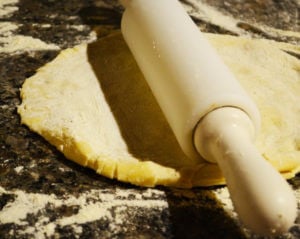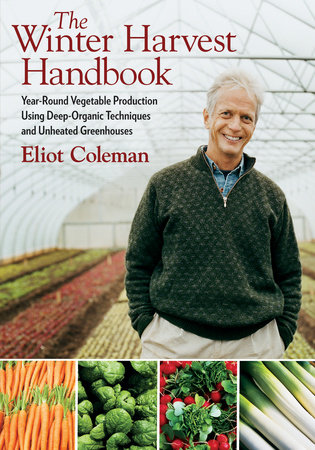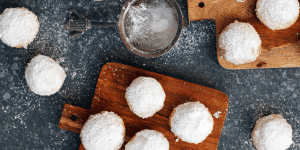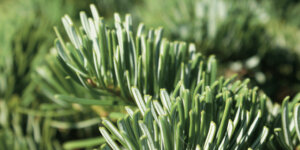Winter Pizza Duo Using a Sourdough Starter
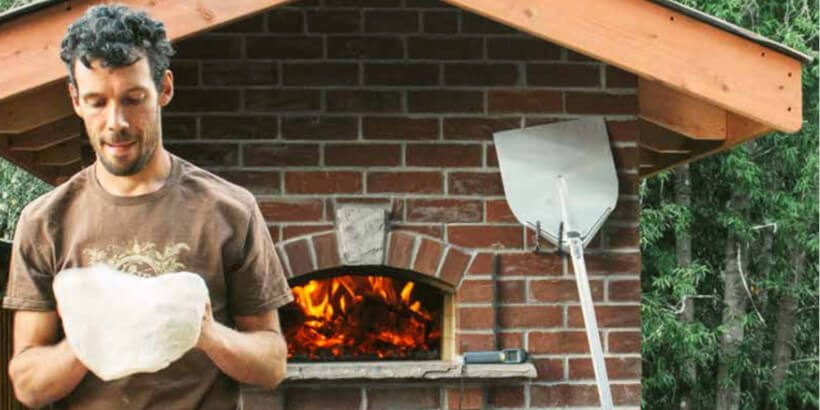
Turn any night into pizza night! This sourdough pizza holds the secret to a stress-free weeknight dinner.
Make the crust ahead of time and let it rise in the fridge. By dinnertime all you’ll need to do is shape the dough, add your toppings, and bake!
This excerpt is from The Occidental Arts and Ecology Center Cookbook by The Occidental Arts and Ecology Center with Olivia Rathbone. It has been adapted for the web.
Photo Credit: Oven built at OAEC by Firespeaking and taken by Tali Aiona.
Making A Sourdough Starter
We are so lucky to be in an area of the world where there is an abundance of wild yeast in the air.
To make a sourdough starter, also known as levain, you have to make an inviting environment for a combination of yeast (Saccharomyces exiguous) and bacteria (Lactobacillus) to live, grow, and give rise to your bread.
This mixture is a paste of our and water, from the freshest wheat berries possible and filtered water.
How to Start Sourdough
It is then set out in your kitchen and allowed to breathe the air you breathe. The starter is freshened or fed every day until you start to see a regular pattern of expansion and contraction from enzyme activity.
Once the sourdough starter rises and falls predictably, it is then stable and can be used every day or fed every day for future use. You will see that taking care of your sourdough starter will be like having an addition to your family.
I started one 12 years ago on rye and wheat that I grew on my farm, and it has continued to live and feed many. I have traveled with my starter across the country twice and shared it with family, friends, and even strangers.
This ancient act of tending yeast is so simple and yet so profound: to make leavening happen from two tangible ingredients and a third immeasurable ingredient – spirit.
 Sourdough: Taming the Wild Yeast
Sourdough: Taming the Wild Yeast
Day 1
Have ready a clean quart-sized container, either a jar or a plastic container with a lid. In the container, mix 1/2 cup filtered water with 1/4 cup rye flour and 1/4 cup white bread flour.
Mix well with a spoon and scrape the sides and flatten the paste. Leave this starter out, covered, for 24 hours in a warmish room.
Day 2
Hopefully, you can see some activity on day 2—a few bubbles here and there, and perhaps a rise in the dough mix from the day before. If you see no growth or bubbles, then leave it for another 12 hours.
Discard all but 1/3 cup of the starter paste and feed it with 1/3 cup water, 2 tablespoons rye flour, and 1/3 cup white bread flour.
Day 3 and On
Feed as you did before: 1/3 cup starter, 1/3 cup water, 1/3 cup white bread flour, and 2 tablespoons rye. Continue doing this every 12 hours.
By day 4, the starter will be very active and will fall into a predictable rhythm of rising and falling. At this point, you can feed the starter all white flour; by days 5 through 7, you should have a natural levain sourdough starter!
If you want to grow your starter to a larger volume, just use the equal proportions (for the miche recipe here, you will want to grow the starter—1 cup starter, 1 cup water, 1 cup flour).
If you will not be using your starter every day and don’t have time to feed it, you can put it to rest in the refrigerator.
Make sure it is in a sealed container and take it out to feed every 1 to 2 weeks. Discard any dark water that collects on the top and feed as above, with equal parts starter, water, and flour.
Winter Pizza Duo
Resident chef Gabriel Tiradani created these pizzas in the heart of winter-time, long after the last ripe garden tomato came through the kitchen, and wanted to highlight the garden offerings of winter in these two pizzas paired together: one with winter pesto, celery root, olives, and almonds; the other with béchamel, winter squash, radicchio, parsley, and lemon.
As always, you are welcome to improvise additional toppings, such as fresh ricotta or chèvre instead of or in addition to mozzarella, or add any fresh herbs that might be ready in your garden.
How to Make Pizza Dough
Serves 6
Ingredients
Makes four 12-inch pizzas
- 3 cups bread flour (1000g dough)
- 1 1/2 cups water
- 1 teaspoon sea salt
- 3/4 cup sourdough starter
Serves 30–40
Makes sixteen 12-inch pizzas
- 13 cups bread flour (4000g dough)
- 6 cups water (70°F)
- 2 tablespoons plus
- 1 teaspoon sea salt
- 3 1/2 cups sourdough starter
Small Batch vs. Large Batch Pizza Dough
To make the small batch:
Place all the ingredients in the bowl of a stand mixer. Mix on low with the dough hook for 2 minutes. Increase the speed to medium and mix for 4 minutes to develop the gluten. The dough should be elastic and smooth.
To make the large batch:
Place all ingredients into a clean bus tub or a 12-quart cambro. Mix by hand using a squeezing motion with your hands.
Have a plastic dough scraper nearby to scrape the sides of the tub down and scrape the dough from your hands. The hand method takes a lot of upper-arm strength; it helps to have the tub you are mixing in about waist-high so that you can lean into it.
Once it is all mostly incorporated, you can start folding the dough over and onto itself to create strength and develop the gluten. Dough should be semi-smooth. Don’t worry if it still looks shaggy; it will smooth out as it ferments and is folded.
Procedure
Place the dough into an oiled bowl or cambro and cover with a dishtowel. Put in a warm place (70°F) to let rise for 2 hours total.
One hour into the rise, fold the dough: Grab one side of the dough, lift up, and let it stretch then fall over the top. Do this to the four sides of the dough and let rise the final hour.
After the dough has risen for 2 hours, turn it out onto a floured counter. With a dough knife, divide the dough into four 250-gram portions (16 portions for the large batch).
Shape the dough portions into tight boules or rounds by cupping the dough in your hand and rolling it against the table in a circular motion. Place the dough balls on a heavily floured sheet pan about 3 inches apart. Wrap well and refrigerate overnight or a minimum of 5 hours.
Preheat the oven to 450°F (if you’re using a baking stone, make sure it is in the oven getting hot while you’re preheating). Remove the dough from the refrigerator. Take each ball of dough and work it open by rotating it in your hand, letting gravity stretch the dough into a bigger circle.
Place onto a well-floured or corn-mealed cutting board or pizza peel. Arrange the toppings. Slide off the peel onto the pizza stone.
Bake until the underside is golden and the crust is dark. Time will vary depending on your oven. Remove, cut, and serve hot!
Sourdough Pizza with Winter Peston, Celery Root, Olives, and Almonds
Serves 4–6 when paired with the other variation*
Ingredients
- 500g sourdough pizza dough, divided into two 12-inch pizzas
- 1 1/2 cups marjoram pistou

- 1/2 pound grated mozzarella
- 2 cups slivered celery root, tossed with olive oil and salt and roasted at 350°F for 25 minutes
- 1/2 cup cured olives, chopped
- 1/2 cup almonds, chopped
- 1 cup grated Parmesan
Serves 30–40 when paired with the other variation*
- 2000g sourdough pizza dough, divided into eight 12-inch pizzas
- 5 cups marjoram pistou
- 1 1/2 pounds grated mozzarella
- 16 cups slivered celery root, tossed with olive oil and salt and roasted at 350°F for 25 minutes
- 2 cups cured olives, chopped
- 2 cups almonds, chopped
- 2 1/2 cups grated Parmesan
Procedure
Stretch out your pizza dough on a cutting board sprinkled with lots of cornmeal to prevent sticking. Layer on the toppings by starting with a thin layer of winter pesto, then mozzarella, then a layer of roasted celery root, olives, and almonds. Top with Parmesan last.
Sourdough Pizza with Béchalmel, Winter Squash, Radicchio, Parsley, and Lemon
Serves 4–6 when paired with the other variation*
Ingredients
- 500g sourdough pizza dough, divided into two 12-inch pizzas

- 13⁄4 cups Basic Béchamel Sauce
- 1⁄2 pound grated mozzarella
- 4 cups cubed winter squash, tossed with olive oil, crushed garlic,
- and salt, and roasted at 350°F for 30 minutes
- 1 large head radicchio, sliced thin
- 1⁄2 cup finely chopped parsley
- Zest of 1 lemon
- 1 cup grated Parmesan
Serves 30–40 when paired with the other variation*
- 1000g sourdough pizza dough, divided into eight 12-inch pizzas
- 7 cups Basic Béchamel Sauce
- 11⁄2 pounds grated mozzarella
- 10 cups cubed winter squash, tossed with olive oil, crushed garlic, and salt, and roasted at 350° for 30 minutes
- 4 large heads radicchio, sliced thin
- 2 cups finely chopped parsley
- Zest of 3 lemons
- 21⁄2 cups grated Parmesan
Procedure
Stretch out your pizza dough on a cutting board sprinkled with lots of cornmeal to prevent sticking. Layer on the toppings by starting with a thin layer of béchamel, then a layer of mozzarella.
Next, a handful of roasted winter squash, sliced radicchio, a smattering of chopped parsley and lemon zest. Finish with the Parmesan last.
Recommended Reads
How to Make a Sourdough Starter: Everything You Need to Know Starter Guide
Recent Articles
The scent of fir trees is a holiday staple 🎄 Imagine sipping a festive cocktail infused with the unmistakable taste of fir ✨ This holiday season, elevate your entertaining game by introducing fir to your menu – from classy cocktails to rustic potatoes!
Read MoreLooking for a way to use that leftover Thanksgiving Turkey? Shake things up this holiday season with a game-changing twist. Serve these easy-to-make appetizers with a side of Vietnamese dipping sauce for an extra kick of flavor!
Read MoreAttention all cheese lovers! If you’re looking for recipes to satisfy all your cheesy needs, then look no further.
Read More

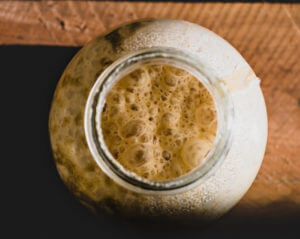 Sourdough: Taming the Wild Yeast
Sourdough: Taming the Wild Yeast